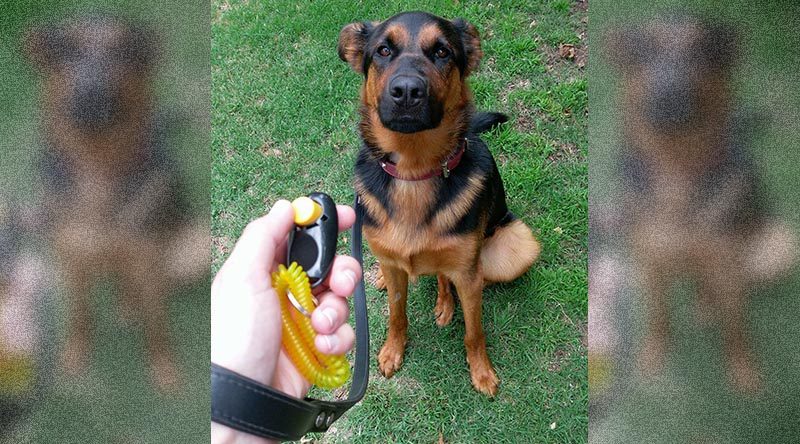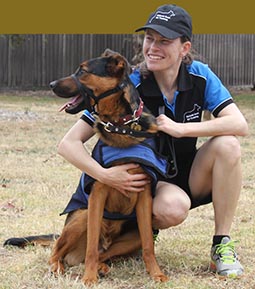Dog training basics – using markers

In dog training it can be useful to use a marker.
What is a marker?
A marker can be either a word or an action.
A marker is used to bridge the time between a dog performing a correct command and the dog actually receiving a reward for that command.
It takes time to take a treat out of your pocket to present to your dog.
A marker immediately acknowledges a correct action and allows you time to reach for the treat.
Essentially you are making a promise to your dog that they will get a treat.
Why use a marker?
Using a marker can strengthen your training, meaning your dog knows the exact moment he has done something right, it takes away any confusion and provides instant feedback to your dog.
If you are busy fumbling around for a treat or walk off to get a toy reward for your dog after he has done something correctly he may have forgotten what it was he did correctly by the time you actually reward him.
Is he receiving food for a sit or is he receiving food by simply following you to the cupboard?
Using a marker defines the exact moment so your dog knows he’s done the right thing and he will be getting rewarded.
Marker word
A marker can be the use of a clicker or the use of a marker word.
A marker word is a bridge word between doing the right thing and receiving a food reward.
As mentioned above, a marker word is a word you use to signal to your dog that a treat is coming.
“Yes” is an example of a marker word.
You want something short and simple.
How do I start to use a marker word with my dog?
Firstly, you need to teach your dog there is value in the marker word.
Grab a handful of treats, say “yes”, give your dog a treat, repeat this 10 times in a row.
If you want to praise your dog and don’t have a treat to give him use a different praise word – “good boy”, “good job”, “well done” etc.
If you use the marker word and don’t give a treat it takes power away from the word.
The marker word must equal a treat!
Training a “look”/ “watch” command
This command will be used to get your dog’s attention and focus on you using a marker word.
Our goal is for our dog to make eye contact with us.
For this exercise I will use “yes” as the marker word, reward is a food treat and “watch” is the command to draw the dog’s attention.
For this exercise it may be easier for your dog to make eye contact with you if he is in the sit position.
Hold a treat in your hand, show your dog the treat, then move the treat slowly up to in between your eyes.
As soon as your dog makes eye contact with you, mark and reward.
Your dog doesn’t have to hold eye contact and he is only learning the exercise so we don’t introduce a command yet.
Repeat this exercise until the dog sees you begin to move the treat towards your face and he looks you in the eyes.
Now we can begin to use the “watch” command as we move the treat towards our face.
As soon as your dog makes eye contact say “watch”, mark and reward.
Repeat five times.
Now say “watch” and see if your dog looks at you.
If he does mark and reward, that’s great!
If he doesn’t, he may still need a little more practice, so go back and repeat the step where we say “watch” as we move the treat towards our face.
Be patient.
Using a clicker as a marker
A clicker, or clicker training uses the same principle as above.
A clicker is a small plastic device held in your hand (some come with a wrist strap).
On the device is a button (clicker) which emits a clicking noise when depressed.
A clicker can emit exactly the same sound regardless of the circumstances which can be useful in training.
A clicker does not differentiate between you sounding excited, tired, raised voice over background noises etc.
Firstly, you need to teach your dog there is value in the clicker.
Grab a handful of treats, click the button, give your dog a treat, repeat this 10 times in a row.
If you prefer to use a clicker you can perform the “watch” command exercise using the clicker instead of the marker word.
Marker words versus clicker – the pros of each
Marker word pros
- You can use it anytime without needing to be in possession of a clicker
- Less obvious in public – clickers make a noise often louder than a person speaking
- Can be a made up word – it only has to mean something to you and your dog
Clicker pros
- A clicker gives exactly the same sound each time, every time
- Anyone can use a clicker to reward your dog, it holds the same value, good for multiple people training the same dog
- Clickers avoid overuse of the marker word without reward, can be particularly handy around children who may copy and repeat what you say
.
Regardless of which technique you use, consistency and practice are key.
The more you use your marker word/clicker and reward your dog, the faster and more responsive your dog will become.
Good luck and happy training!
>
.
,
Melanie Scott is a former police officer with PTSD. She is a qualified dog trainer who is passionate about dogs and helping first responders. Melanie Scott K9 Training (MSK9T) offers a variety of services including group dog-obedience classes, puppy classes, private in-home consults, as well as therapy and service-dog training. You can contact Melanie on 0448 395 797 or visit her web site.
.
.
.
.
.
.
.

.
.






